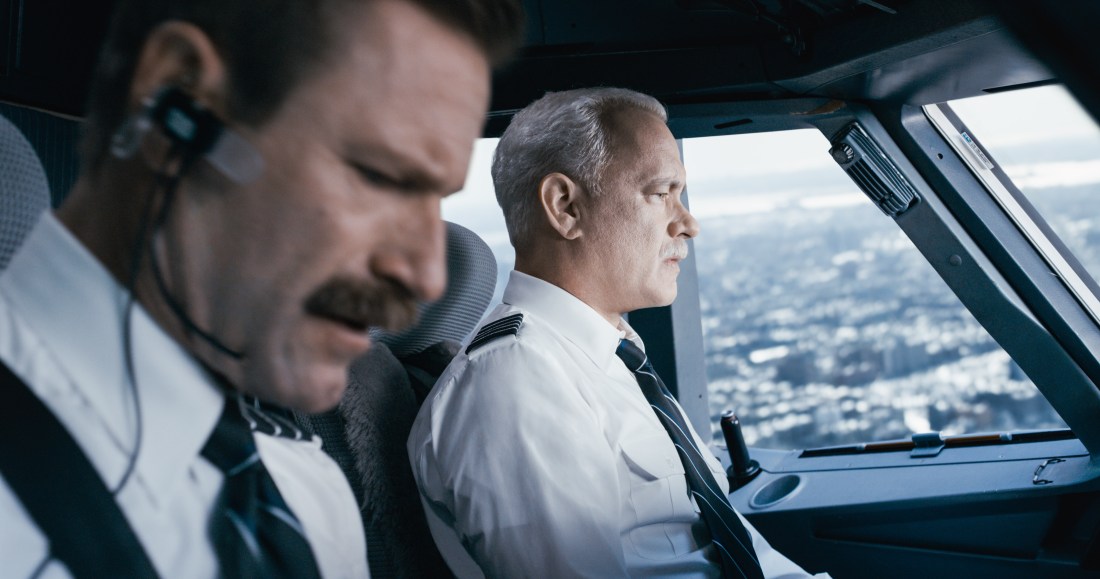
I wanted to love Sully, the 2016* film starring Tom Hanks and directed by Clint Eastwood about airline pilot “Sully” Sullenberger successfully executing an emergency water landing on the Hudson River, but I couldn’t because the movie was crummy. And what grated as I watched: it didn’t have to be.
Critics and audiences liked Sully a lot more than I did. Maybe I’m being too picky. But, I suspect a significant chunk of the positive feeling toward the movie is connected to positive feelings for Sullenberger the man. I share many of those feelings, which is a reason why this crappy movie rankles. Sully deserved better.
To recap (spoiler alert): Sullenberger and crew took off from LaGuardia Airport on a cold winter morning with 155 people on board. At about 2,800 feet, the passenger jet passed through a flock of Canadian geese and suffered “bird strikes” that destroyed both engines. Sullenberger and co-pilot Jeff Skiles ran through options (trying to return to LaGuardia or re-route to nearby Teterboro), and decided their best option was to attempt a water landing. They pulled it off, and all 155 on board survived.
So why did the film crash and sink? First, it suffered from the malady that afflicts many “this really happened” stories. When people already know the outcome of an event, it can be difficult for filmmakers to generate drama. When joining the project, Eastwood reportedly wondered where the antagonist was. Rather than thinking deeper about the story they should tell, Eastwood and company just made one up.
Second, it suffered from self-inflicted wounds. For example, the film opened with a sequence where a passenger jet crashed into New York City buildings. It was a frightening reminder of the 9/11 attacks, but it was a terrible choice for this film because it didn’t happen. It was a nightmare suffered by the film’s version of Sully. I haven’t read the source material, but I assume the scene was based on his actual nightmares. But…
Third, the real-life events were a triumph of teamwork, preparation, and training. The water landing was the culmination of Sullenberger’s lifetime of work and attention to detail. It was a symphony of teamwork between him and Skiles, as well as the calm, swift actions of the flight crew, air traffic controllers, ferry boat drivers and rescue workers. By focusing on Sullenberger’s nightmare and post-traumatic stress disorder, filmmakers introduced a sourness that pervaded everything.
Fourth, while making a “this happened” story, filmmakers scabbed on a happy ending by creating a preposterous scene that never happened.
In short, Sully was a bad movie because of storytelling decisions.
How could it have been good? How could the film have mined drama from a brief event where the outcome is known?
By shifting the focus.
Sully Sullenberger, the person, was extraordinary. He was among the best at nearly everything he tried to do for nearly his entire life. He studied and worked and trained, and eventually became so good at flying aircraft that he became a trainer and safety investigator.
His co-pilot, Jeff Skiles, had a story. So did the flight attendants who helped implement safety protocols that got every passenger off the plane alive.
I can see several different ways to attack the story, all of which could have been dramatic, interesting, and remained true to the lives of these heroic people.
One option would have been a biopic of Sullenger. Show his upbringing, his schooling, his learning to fly, his intense training. Those sequences can carry some drama because each of those steps is about a determined person overcoming obstacles in pursuit of a goal. What might have been cool was to craft the scenes in such a way that they highlight the reality that no person is truly self-made (a point Sullenberger makes in speeches), and that teamwork is essential in nearly every human endeavor (another point he makes).
Another option would have been to have multiple story lines about key figures in the water landing and safely getting all passengers out of the airplane. This could have opened rich lines for storytelling, because many people were involved in the rescue, and and at least some of them have interesting stories worth telling.
There are still other storytelling options, all of which could have centered around the core lessons to be drawn from Sullenberger’s life: work hard, prepare, and collaborate.
